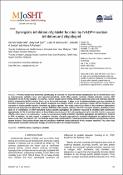Options
Synergistic inhibition of platelet function by NADPH oxidase inhibitors and clopidogrel
Journal
Malaysian Journal of Science, Health & Technology
Date Issued
2021
Author(s)
Siti NS Abdul Jalil
Laila M Abdelrahim
Zahidah A Seman
DOI
10.33102/mjosht.v7i2.144
Abstract
Previous studies have shown platelets play an important role in prothrombotic complications due to several factors such as hyperglycemia, oxidative stress, and hypercholesterolemia, which affected platelets reactivity. Platelets activation involves ADP stimulation via P2Y12 receptor, whereas reactive oxygen species (ROS) including superoxide anion and hydrogen peroxide (H2O2) produced by NADPH oxidase (Nox) act as the second messenger, which involved in platelets activation and may contribute to thrombus formation. The aim of the present study was to investigate the influence of Nox on the purinergic receptor (P2Y12 receptor) in activation of human platelets function stimulated by platelets agonist. This research explored the effects of Nox inhibitors and clopidogrel either alone or in combination, on various agonist-stimulated human platelets, including platelets aggregation and adhesion measured by modified LTA, expression of platelets activation markers, and calcium mobilization using flow cytometry, and ROS formation, NADPH oxidase activity, as well as cAMP levels by chemiluminescence assay. Taken together, findings from these experiments suggest that the combination of clopidogrel and Nox inhibitors synergistically reduced platelets aggregation, platelets adhesion, and expression of platelets activation marker during late activation, ROS formation, NADPH oxidase activity, calcium mobilization and increased cAMP levels in vitro. This combination showed that P2Y12receptor reactivity was influenced by the activation of NADPH oxidase. Thus, these data demonstrated a potential combination therapy to reduce the risk of thrombosis formation.
Subjects
File(s)
Loading...
Name
Synergistic inhibition of platelet function by NADPH oxidase inhibitors and clopidogrel.pdf
Size
279.02 KB
Format
Adobe PDF
Checksum
(MD5):4e38d87e1c148786d6ca96ca45fbb7fe